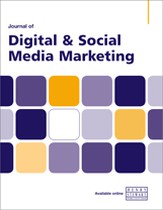Not another ad! Expectancy violation effects of advertising clutter on social media
Abstract
This study examines the interaction of social media users’ expectations regarding advertisement clutter, actual physical advertisement clutter and information processing needs when estimating the perceived intrusiveness of advertisements and attitude towards advertisements. Specifically, an online experiment (n = 170) supports the three-way interaction of expected advertisement clutter, physical advertisement clutter and need for cognition (NFC) vis-à-vis perceived advertisement intrusiveness, and the intrusiveness of an advertisement subsequently impacts attitude towards that advertisement. The findings suggest that perceived advertisement intrusiveness is influenced by the extent to which the expected advertisement clutter correlates with the actual advertisement clutter, and this effect is dependent upon the individual’s NFC level. The results also highlight the long-term negative effects of advertisement clutter and that high advertisement relevance might not be sufficient to offset the negative effects of both physical advertisement clutter and expected advertisement clutter.
The full article is available to subscribers to the journal.
Author's Biography
Sieun Ha is a PhD student at the Stan Richards School of Advertising and Public Relations at the University of Texas at Austin. Her research examines information processing and new advertising tactics, including influencer marketing, social media and artificial intelligence. She previously worked as an account planner at the largest full-service advertising agency in South Korea and served over 50 clients in mobile tech, game and electronics sectors across diverse international markets.
Matthew S. Eastin is a leading researcher in the fields of advertising, media studies and communication, with a focus on social cognitive approaches to consumer behaviour, media engagement and emerging technologies. His work examines how and why audiences interact with newer media, addressing critical societal issues such as media consumption, consumer privacy perceptions and the impact of immersive technologies like mixed and virtual reality, as well as artificial intelligence. Dr Eastin has made significant theoretical contributions to various fields, including advertising, media, information science, psychology, health and communication.
